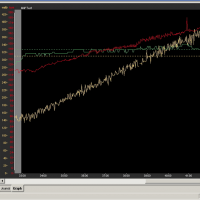With our recent focus on power training and determining FTP, this article by Jennifer Snow Ashbrook has been updated.
We’ve discussed various methods for estimating functional threshold power (FTP) in past articles. In this article, we focus on an alternative method for establishing power-based training zones—the maximal aerobic power (MAP) test. We also provide you with a downloadable profile complete with play-by-play coaching cues and music suggestions, as well as a downloadable spreadsheet to determine your riders’ FTP and calculate their training zones from their MAP test.
The MAP test is a “ramp” test, a testing approach commonly used in Britain and Australia. TrainerRoad, an online cycling training software, has replaced its previous suggested 20-minute and 8-minute FTP tests with this very same ramp test.
The ramp test has some advantages and some disadvantages compared with FTP testing protocols previously discussed.
One advantage is that the test is over pretty quickly and pacing is not an issue like is with longer FTP tests. However, since the endpoint of this test is “failure,” it’s probably not a good choice for new or deconditioned riders. On the other hand, it’s only the final 2 or 3 minutes that are “hard,” and only the final minute that is “very hard.” If your riders can do an all-out 3-minute test, they should be able to do this one.
The test protocol itself is pretty simple: After a thorough warm-up, riders gradually ramp up power in steps until they cannot sustain the effort any longer. The average power from the final successful minute of the test is used to estimate FTP, which is then used to establish training zones.
Following is a more specific description of the test:
Be sure to check out these articles on FTP training.
You‘ve Got Your FTP Number…Now What?
20-Minute FTP Test: Coaching Play by Play
FTP Field Testing Music Tips and Suggestions
And to prepare your riders for the rigors of FTP testing, here is a 5-part series on teaching longer intervals.
How to Incorporate Long Intervals, Part 1: Why Longer Intervals Are Important


Thank you for this great article, can’t wait to do it with my riders.
I’m noticing that the talk is more about power now and I love it, I use it all the time, we have amazing bikes with power meters , in addition all my riders have got the app on there phone where they have multiple screens including a FTP % screen which shows them what % they are working at according to the zone they are in with the data collected before from doing FTP testing.
Is it still important to do LT testing to find Hr or should we focus on power and then check in with the HR?
I loved this workout! I did not find the spreadsheet to calculate zones – would love to get it!! Thanks!
Another great article to reinforce the importance of introducing/using power measurement/monitoring to indoor cycling. This very detailed description outlines nicely the use of the RAMP test anyone should be able to understand. As an indoor power-certified instructor and an outdoor rider who also trains using power you really nailed this. Great job….
Thanks, Dave! Appreciate the feedback.